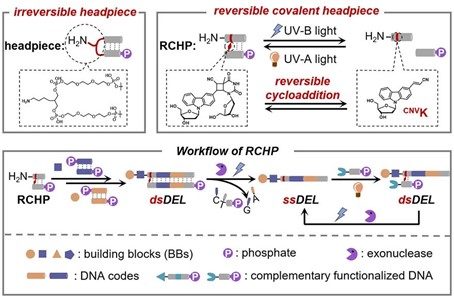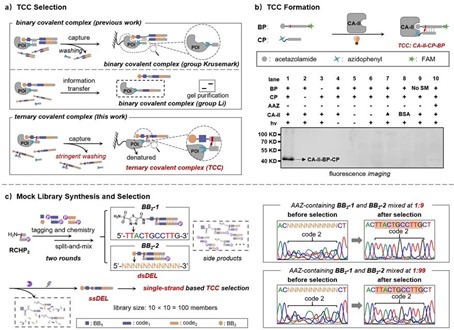The Medicinal Chemistry Biology Group of Chongqing University has published an article in Angewandte Chemie International Edition entitled "Reversible Covalent Headpiece Enables Interconversion between Double-stranded DNA-encoded Chemical Libraries".

The discovery of lead compounds is the starting point for innovative drug development, and it’s also a difficult point in drug development. DNA-encoded chemical library (DEL), as a novel high-throughput and low-cost lead compound discovery platform, has attracted widespread attention from domestic and foreign pharmaceutical companies and academia.
The encoding method is one of the cores of constructing DEL, which greatly affects the quality of library and the final screening result. The most commonly used encoding method is based on a covalent double-stranded hairpin-shaped DNA "headpiece" strategy developed by GlaxoSmithKline (GSK). Stable double-stranded DNA has advantages of simple design and high efficiency in construction of DEL, but it’s not compatible with single-stranded DEL with various potential application. It has become an important trend to pursue the balance between double-stranded and single-stranded DEL.
Here, we report a novel encoding method based on “reversible covalent headpiece (RCHP)”, which realizes the reversible conversion between double-stranded DEL and single-stranded DEL. Under simple light reaction conditions, the strategy not only ensures the efficient synthesis of double-stranded DEL, but also is compatible with subsequent diversified applications of single-stranded DNA-encoded chemical library.

Subsequently, the research team used the Encoded Self-assembling Chemical Libraries (ESAC) and DNA-Encoded Dynamic Libraries (DEDL) systems to verify the generality of the encoding method. It’s worth noting that the library constructed by RCHP has the unique property of forming a "target-covalent probe-encoding DNA" ternary covalent complex (TCC). By applying TCC to DEL’s slection, we discovered active lead compounds of non-immobilized targets in complex living systems.

In conclusion, we have developed a novel DEL-encoding method with reversible covalent headpieces, which enable the interconversion between double- and single-stranded DEL forms via photo-crosslinking, enzymatic degradation, and photo-splitting. This strategy integrates the robustness of dsDEL synthesis and the versatility of ssDEL applications.
The first authors of this article are Zhao Guixian and Zhong Shuting, students of Chongqing University. and the research content belongs to the Chinese patent (CN112760720A).
This work was supported by grants from the National Natural Science Foundation of China (21907011, 22107016, 22107017), the Fundamental Research Funds for the Central Universities (2020CQJQY-Z002, 2021CDJYGRH-002), graduate research and innovation foundation of Chongqing, China (Grant No. CYB21074), the Natural Science Foundation of Chongqing (cstc2020jcyj-jqX0009, cstc2021jcyjmsxmX0016, cstc2021jcyj-cxttX0002), and the China Postdoctoral Science Foundation (2020M683251).
Related link: https://doi.org/10.1002/anie.202115157